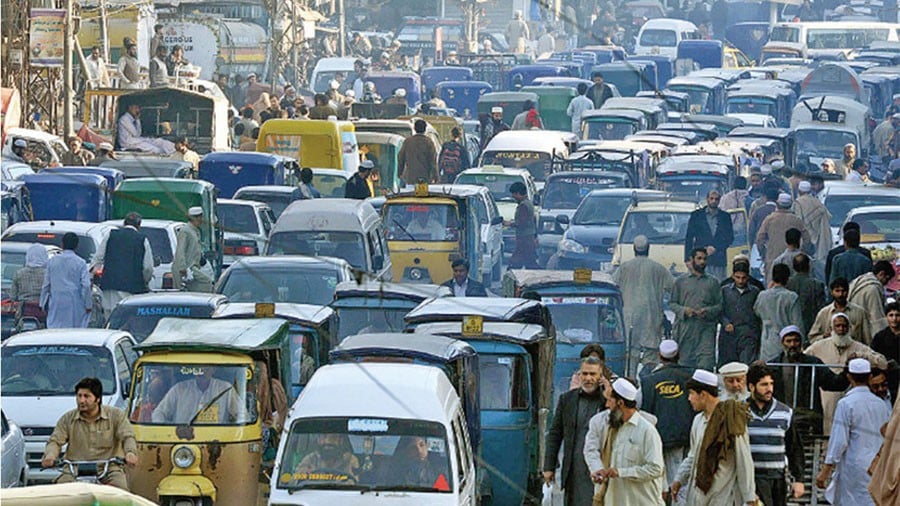
In-migration triggered by militancy and law and order poses a grave challenge to the KP government

Although migration and urbanisation is a nationwide trend over the decades, the Peshawar Valley in Khyber Pakhtunkhwa (KP) stands as the most glaring example of this phenomenon with migration streams constituting millions of forced in-migrants since 1980s.
The Peshawar Valley consists of five central districts of KP, namely: Peshawar, Charsadda, Nowshera, Mardan and Swabi. The valley represents a unique set of circumstances with regard to in-migration and urbanisation. It has ethnic affiliation with conflict-ridden northern KP, Federally Administered Tribal Areas (FATA) and Afghanistan.
Importantly, the valley’s central location within KP affords the above regions’ geographical proximity and access to the valley. Its relatively better law and order situation is also an important factor for people of conflict areas. Hence, the Peshawar Valley has received the highest number of in-migrants since political turmoil began in the Pashtun region in the 1980s.
The in-migration factor -- coupled with yearly natural increase of the valley’s own population -- has fueled unchecked urban growth in the form of squatter settlements. This has been witnessed throughout the five districts constituting the Peshawar Valley.
Successive KP governments have not empowered local government agencies adequately to respond effectively to infrastructural and environmental challenges of such urbanisation. There is little decentralisation of power, transparent use of funds, upgradation of infrastructure, investment in sustainable urban development and population control.
Due to absence of the above measures, the 2011 Millennium Development Goals (MDG) report of KP identified the province’s urban areas as the poorest with little provision of basic social services. Several of these areas are concentrated in Peshawar Valley, which continues to host the population displaced due to militancy and natural disasters.
According to another study conducted by the United Nations-Habitat in 2013, "KP is experiencing rapid urbanisation and has grown by 23 per cent between intercensal periods of 1981-1998. This level of urbanisation is likely to be close to 50 per cent if the present trends continue with the Peshawar Valley experiencing the greatest growth of urban and suburban settlements."
The current urbanisation of the Peshawar Valley is being accelerated by three kinds of in-migrants. There are those who migrate from rural areas of KP and FATA for better economic opportunities, those that arrive for access to social services, such as education and medical care, and those forced migrants that flee militancy or political persecution. The last factor is unique to the Pashtun region.
The rise of militancy in various parts of the region has become a constant factor that forces people to migrate to Peshawar Valley for the short-term, medium-term or even long-term settlement. Since the anti-Soviet War in the 1980s, the valley has hosted millions of Afghan refugees until very recently. Moreover, since the commencement of military operations in FATA and then northern KP, the Internally Displaced Persons (IDPs) were added to this displaced population that sought refuge in various districts of the Peshawar Valley.
Initially, the populations of the affected areas perceived that the militancy would be eliminated in a matter of months, as the authorities in Peshawar Valley issued registration cards to IDPs only for 36 months for receiving food aid. However, the occurrence of sporadic attacks did not allow normalcy to be fully restored in FATA. Schools, especially those for females, continued to be blown up, and according to a student from FATA who migrated to Peshawar, "We were threatened to leave school or else face bombs and bullets."
In many cases, schools could not be reopened due to continued precarious situation in FATA. Similarly, families with Pashtun political affiliation faced heightened risk of persecution.
Owing to these factors, along with opportunities for better income for the poor, people from FATA and northern KP permanently shifted their families. According to KP’s Social Welfare Department, a majority of the 514,806 displaced families were accommodated in Peshawar, Mardan and Charsadda.
Despite the slogan of ‘change’ and promise of empowerment of local governments by the Pakistan Tehreek-e-Insaf (PTI) government, there have been widespread allegations of corruption, nepotism and mismanagement on provincial and district council levels. This has affected efficiency of local bodies in managing the IDPs.
Additionally, only 20 per cent in-migrants reside in IDP camps and the rest are forced to live in urban slums. They tend to be employed in the informal economy sector of Peshawar Valley, with poor quality of life and degraded environment. The valley is thus, the fastest urbanising region of KP, facing overstretching of its already fragile infrastructure and scarce natural resources.
Certainly, urbanisation is occurring, but there is more urban decay than urban development. Population is growing, hospitals and schools are overburdened, traffic is congested, pollution (including that in water supply) is increasing, and solid waste and sewerage management are poor. For the affluent, new ‘gated communities’ are being established at the expense of prime agricultural lands of the Peshawar Valley.
Despite departure of Afghan refugees, reverse migration of IDPs to places of their origin is less than desired. Reasons include lack of security and non-provision of key infrastructure in their hometowns. Thus, there seems to be no mitigation in the continuing rapid urbanisation of the Peshawar Valley.
Lack of research on push factors for migration in the Pashtun region only compounds the existing problems. The current census, however, offers a ray of hope for assessing the situation of IDPs living in urban slums of the Peshawar Valley and, accordingly, planning for civic amenities in their places of origin.
To be fair, urbanisation may not necessarily be a bad phenomenon, provided the right infrastructure and optimal management of resources exist. The Peshawar Valley exhibits marked deficit on these accounts. There is also little population control causing overcrowding of the valley.
Ensuring sustained law and order and decentralisation of powers in KP and FATA are needed to arrest further migration-induced urbanisation.